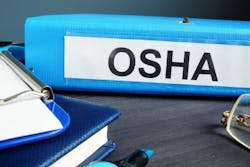29CFR 1926 Subpart M, which provides the requirements fall protection, begins with 1926.500. This subpart provides the “scope and applications” [1926.500(a)] and definitions [1926.500(b)]. It’s about a page and a half, but it is fairly dense. One reason there are so many fall protection citations is the responsible parties at companies fail to take the time to study and understand this foundational text.
Here are some scope and applications highlights:
- This subpart doesn’t apply when employees are making an inspection, investigation, or assessment of workplace conditions prior to the start of construction work or after all work is completed. It does apply in all other circumstances related to that work.
- Certain types of work (e.g., using cranes, steel erection work, etc.) are covered in other places [1926.500(a)(2)ii through vii].
- Section 1926.503 provides the requirements for training in the installation and use of fall protection systems, except in relation to steel erection and the use of equipment covered by subpart CC.
The big takeaway from the scope and applications is that you also need to refer to other applicable parts of 29CFR 1926. And, fortunately, those are identified in 1926.500. It is still a good idea to go through the table of contents to see if there is anything else that applies to the particular work, fall protection or not. Laxity in those other areas will set a low mental standard for compliance in this area.
Very few people enjoy sitting down and reading the dictionary. When is the last time you had people over for a dictionary reading? What about a ball game or movie, instead? But you don’t have to sit down and read all of these definitions until your mind goes numb. A proven way to increase the size and accuracy of your vocabulary is to study three to five words per day. It won’t take many days until you have painlessly gained an understanding of what OSHA means when using these particular words.
To study, read the definition. Then look away from the page (looking up is a common method) and try to recite the definition. If you didn’t get it, go back and read it again. Once you can recite this definition, move on to the next word. Note where you left off, and pick up the next day with a new set of words starting with where you left off.
Doing this won’t mean that six months from now you can recite the definition of any of these words. But when you hear or read them, you’ll know what OSHA means. If memory is a little fuzzy, you can always look the word up again.
An example of a term you need to know is “low slope roof.” What is a low slope? Ask six different people outside the industry, and you might get eight different answers. They will never guess the OSHA definition. It’s a definition you need to know. What about “steep roof”? That’s in there too.
“Opening” is another one with an OSHA-specific definition. It’s a gap or void of specific dimensions (or greater) — not just any opening.
Some terms will seem obvious if seen together. For example, “body belt” and “body harness”. It doesn’t take much to figure out that one of these just goes around your waist and the other has more to it.
One way to reinforce the vocabulary learning is to see these things in the field. If you see a snaphook and actually use it, now you know what a snaphook is, and you’ll never have to look up the definition.
Without the basic understanding that comes from being familiar with 1926.500, you will have difficulty designing or managing a fall protection program that complies with Subpart M. Gain the understanding, and you prepare yourself for success.
About the Author

Mark Lamendola
Mark is an expert in maintenance management, having racked up an impressive track record during his time working in the field. He also has extensive knowledge of, and practical expertise with, the National Electrical Code (NEC). Through his consulting business, he provides articles and training materials on electrical topics, specializing in making difficult subjects easy to understand and focusing on the practical aspects of electrical work.
Prior to starting his own business, Mark served as the Technical Editor on EC&M for six years, worked three years in nuclear maintenance, six years as a contract project engineer/project manager, three years as a systems engineer, and three years in plant maintenance management.
Mark earned an AAS degree from Rock Valley College, a BSEET from Columbia Pacific University, and an MBA from Lake Erie College. He’s also completed several related certifications over the years and even was formerly licensed as a Master Electrician. He is a Senior Member of the IEEE and past Chairman of the Kansas City Chapters of both the IEEE and the IEEE Computer Society. Mark also served as the program director for, a board member of, and webmaster of, the Midwest Chapter of the 7x24 Exchange. He has also held memberships with the following organizations: NETA, NFPA, International Association of Webmasters, and Institute of Certified Professional Managers.
